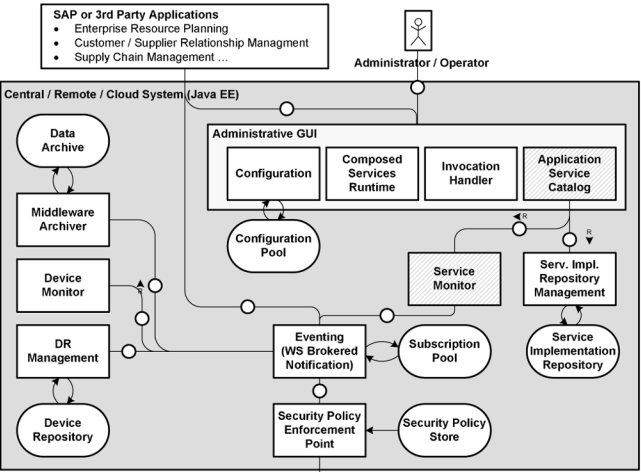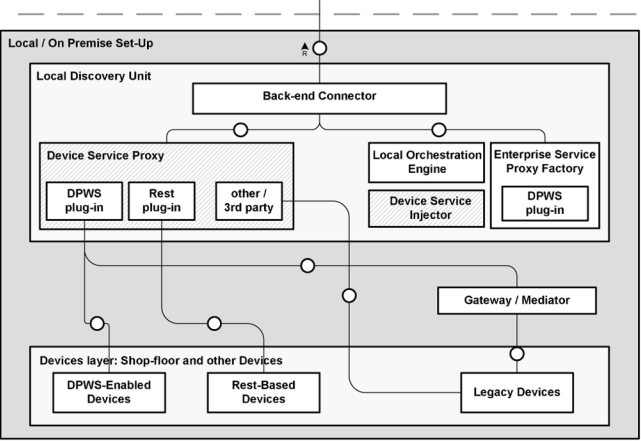1.Info: IEEE Transactions On Services Computing,2010
2.Abstract:
This article mainly proposes a process and a suitable system architecture that enables developers and business process designers to dynamically discover, query, select, and use running instances of real-world services or even on-demand deploy new ones, all in the context of composite, distributed business real-world applications.
3.Main concepts:
- IoT: Internet of Things
- IoS: Internet of Services
- P2P: Peer to Peer
- WSN: Wireless Sensor Network
- DPWS: Device Profile for Web Services. It defines a minimal set of implementation constraints to enable (secure) web service messaging, discovery, and eventing on resource-constrained devices. And it is fully aligned with web services techonology and includes extension points , allowing for seamless integration of device-provided services in enterprise-wide application scenarios.
- REST: REpresentational State Transfer
- OPC-UA: Object linking and embedding for Process Control-Unified Architecture
- SLP: Service Location Protocol
- UPnP: Universal Plug and Play
4.Motivation:
To ensure interoperability across all systems, recent work has focused on applying the concept of SOA directly on devices. Implementing WS-* standards on devices presents several advantages in terms of end-to-end integration and programmability, by reducing the need for gateways and translation between the components. This enables the direct orchestration of services running on devices.
However, implementing WS-* standards directly on devices is not always straightforward. Unlike enterprise services, real-world services are deployed on resource constrained devices, this requires significant simplification, optimization, and adaptation of SOA tools and standards . Additionally, real-world services are found in highly dynamic environmentswhere devices and their underlying services constantly degrade, vanish, and possibly re-appear. This implies the need forautomated, immediate (dynamic) discovery of devices, and services as well as their effective management.
Another crucial challenge is : How to find adequate services for solving a particular task? The approach ,registering or finding a service with UDDI, is adequate for a rarely changing set of large-scale services, but not hold for the requirements of the dynamic real-world services.
5.Main idea:
The authors recognize the challenges posed by the problem of implementing SOA and especially WS-* standards on resource constrained devices. The four requirements identified for this system which form the basis for the design and implementation of the various processes within SIA are:
- R1: Minimal Service Overhead(for providing the functionality of embedded devices as services). As most real-world services are offered by embedded devices with (very) limited computing capabilities there is a need for a lightweight service-oriented paradigm which does not generate too much overhead compared to using functionality through the proprietary APIs.-------------Solution:1) use the DPWS and its dynamic discovery mechanism;2) Resource Oriented real-world devices, which is embedded devices providing their functionality through a RESTful API.
- R2: Minimal Registration Effort. A device should be able to advertise its services to an open registry using network discovery. The process should be “plug and play”, without requiring human intervention. A device should also be expected to provide only a small amount of information when registering.----------Solutions: same approach with solution for solving R1.
- R3: Support for Dynamic and Contextual Search. It should be possible to use external sources of information to better formulate queries. Furthermore, the queries should go beyond simple keyword search and take into account user-quality parameters such as context (e.g., location, Quality of Service (QoS), application context). Support for context is essential as the functionality of most real-world devices is task-specific within a well-defined context.---------Solutions: taking into account the user context and matching it with the extracted context of real-world services.
- R4: Support for On-Demand Provisioning. Services on embedded devices offer rather atomic operations, such as obtaining data from a temperature sensor. Thus, while the WSN platforms are rather heterogeneous, the services that the sensor nodes can offer share significant similarities and could be (re)deployed on-demand per developer request.-----------Solutions: use a software architecture that enables the developer to automatically deploy services on devices when no requirement-satisfying service was found in the environment.
All four requirements are addressed by the Real-World Service Discovery and Provisioning Process (RSDPP) which is the focus of the paper. At a very high level, the process employs two approaches: Device Profile for Web Services (DPWS) which defines a limited set of WS-* standards for implementation on resource-constrained devices and a lightweight alternative which is a RESTful API.
Then the authors give the SOCRADES integration Architecture(SIA):


The rest of the paper focuses on the registration, discovery and provisioning sub-processes within RSDPP.
Why would one take the effort of exposing embedded functionality of devices in a service oriented fashion? The authors mention three specific advantages:
- elimination of proprietary driver software;
- promotion of horizontal integration between devices and vertical integration with enterprise application systems;
- and the reduced need for gateways for translation.
5.Suggestion:
i)The author suggest to use queries to search services metadata and avoid the construction of domain ontologies and to minimize the amount of data that embedded devices need to provide upon network discovery of device and service registration.(real-world devices are resource-constrained devices). In the paper, the author propose a system that use services on the web to extend queries without involving communication with the embedded devices or requiring complex service descriptions from them.
And the authors also think, to satisfy the requirement of real-world service discovery , we should modeling the context by two parts:
- digital environment: is composed of application context(business application) and Quality of Service(such as current status of the service and network transmission delay).
- physical environment: is mainly composed of information about location.
ii)The author suggest to use Web Service Standard(DPWS) and Web-Oriented pattern(REST) to easily integrate physical devices into existing enterprise information systems.
- Why DPWS? Why REST? The lightweight aspect of REST makes it an ideal candidate for resource-constrained embedded devices to offer services to the world ; However, REST service salso have certain limitations and do not always solve problems. While REST services are well adapted for rather services, which coverthe a great part of services available on embedded and real-world device, their limitations become evident when it comes to modeling services which require complex input and/or deliver complex outputs. So the authors suggest that WS-* services are to be preferred for highly complex real-world integration and rather static use-cases, However, for smaller and more user-oriented applications, the RESTful approach offers many advantages such as light and simple use, browsability of services, and a much looser coupling. Thus, our decisionto support both DPWS and REST enabled devices.







 本文提出了一种适用于资源受限设备的服务发现与供给过程(RSDPP),该过程支持轻量级服务模型并允许设备以即插即用的方式注册其服务。RSDPP能够支持动态上下文搜索及按需供给服务,并通过采用DPWS和REST两种方式实现。
本文提出了一种适用于资源受限设备的服务发现与供给过程(RSDPP),该过程支持轻量级服务模型并允许设备以即插即用的方式注册其服务。RSDPP能够支持动态上下文搜索及按需供给服务,并通过采用DPWS和REST两种方式实现。

















 被折叠的 条评论
为什么被折叠?
被折叠的 条评论
为什么被折叠?








